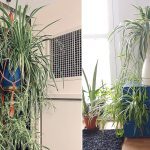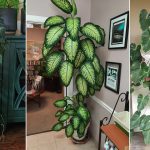Wondering how to flourish hoya variety to perfection? Let’s decode the steps with Hoya Caudata Sumatra Care Guide!
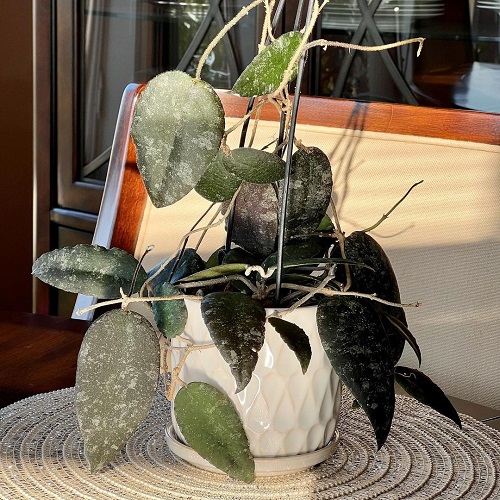
Native to Southern Thailand, Peninsular Malaysia, Singapore, Sumatra, and Borneo, Hoya Caudata Sumatra stands out with its lance-shaped foliage and a vining habit. Learn all about growing this houseplant with this comprehensive care guide!
- Botanical Name: Hoya caudata
- Popular as—Hoya caudata ‘Sumatra’, Wax Plant
- Prefers bright, indirect sunlight
- Thrives in a temperature range of 60-95 F (15-35 C)
- Non-toxic to pets and humans
Learn Growing Hoya Rosita Indoors Here
What is Hoya Caudata ‘Sumatra’?
Hoya Caudata ‘Sumatra’ is a vining epiphyte belonging to the genus Hoya, which encompasses a diverse group of tropical and subtropical vines in the family Apocynaceae.
Each leaf is about 2-4 inches in a deep green color, which contrasts beautifully with random silver-gray speckles, giving it a dusty look. The surface of the leaves is typically shiny, with a waxy texture, earning the plant its common name.
With slightly curved edges, the leaves form a kind of shallow bowl shape, adding to its sculptural quality. In some cases, the edges may even be slightly red, which becomes even more prominent under sunlight.
Hoya Caudata ‘Sumatra’ Flower
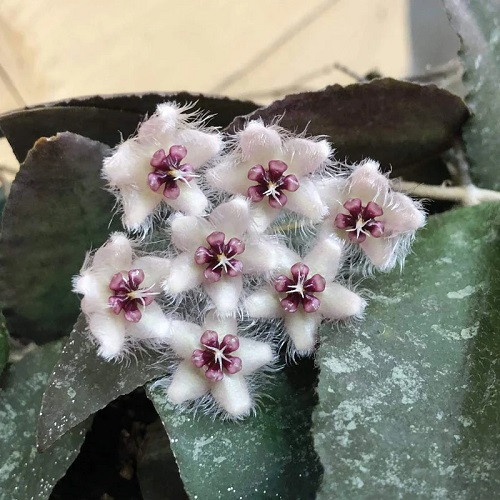
The Hoya Caudata Sumatra Flower showcases a symmetrical star-shaped form. With delicate petals in shades of white, cream, or pink, this flower exudes a subtle vanilla-like fragrance. Adorned with fine details and a waxy texture, it emerges from slender stalks, multiplying the plant’s beauty.
Hoya Caudata Vs Caudata Sumatra
Hoya Caudata and Caudata Sumatra are terms used interchangeably to refer to the same plant. They share similar features, including lance-shaped leaves with prominent veins, glossy green foliage, and star-shaped flowers that emit a subtle fragrance.
Ideal Pot Size
The ideal pot size for Hoya caudata depends on the plant size. For young plants, a 4-5 inches pot is good enough, allowing for root growth without overwhelming them. As the plant matures, gradually transitioning to a 6-8 inch pot provides ample space for further growth. Drill enough holes at the bottom to aid drainage.
Know Everything About Growing Hoya Rangsan Indoors Here
Hoya Caudata ‘Sumatra’ Propagation
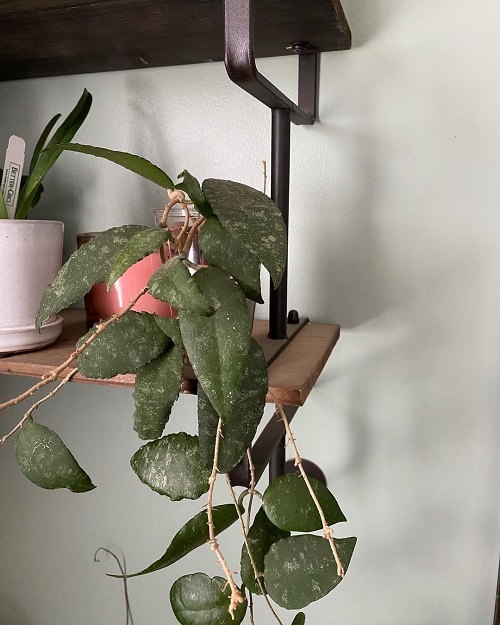
Stem cutting is the easiest way to propagate Hoya caudata ‘Sumatra’. Here’s the way to do it:
- Select a healthy stem with at least two leaf nodes.
- Using a sharp, sterilized clipper, cut the stem just below a node to get a 2-4 inches stem.
- Remove any leaves near the lower part of the cutting.
- Allow the cutting to dry for a few hours to prevent rotting.
- Prepare a well-draining potting mix and insert the cutting into the soil, ensuring the node is covered.
Water the cutting lightly and place it in a warm, bright location. Maintain a slightly moist soil environment and provide indirect light. In a few weeks, roots will begin to develop, indicating successful propagation.
Hoya Caudata ‘Sumatra’ Care
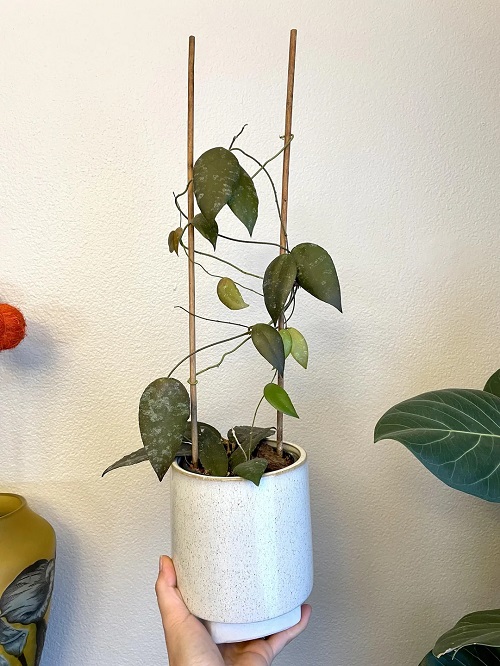
Light
Ideally, place your Hoya variety in a north- or east-facing window, where it can receive filtered or indirect sunlight. Do remember that Inadequate light exposure can result in leggy growth and fewer flowers; similarly, overexposure can scorch the leaves. If natural light is limited, supplement with artificial grow lights to provide the required light intensity for optimal growth.
Soil
Hoya Caudata Sumatra thrives in moist, well-drained soil. A recommended mix includes equal parts perlite, peat, and orchid mix, enhancing both moisture retention and drainage. Additional elements such as charcoal or fir bark can benefit soil structure and nutrient balance. The soil pH should ideally range from 6.1 (slightly acidic) to 7.5 (neutral) to ensure effective nutrient absorption.
Water
To keep your Hoya Caudata healthy, you should water it once a week, but only when the top inch of the soil is dry. This can change depending on how warm or humid it is. It’s better to use distilled or filtered water that’s room temperature so it doesn’t harm the plant. Saturate the medium, allowing the excess water to drain out—this method will ensure the roots get a good shower without pooling excess water in the bottom.
When it’s winter or when the plant isn’t growing much, you should water it less often. This helps the soil get a bit drier between waterings and stops the plant from getting too much water.
Temperature & Humidity
Hoya caudata Sumatra thrives in warm and consistent temperatures, ideally ranging between 60-95 F (15-35 C). Avoid exposing the plant to drafts or sudden temperature fluctuations, as it prefers stable conditions.
Maintaining moderate to high humidity levels is beneficial for the wax plant. It appreciates a humid environment, similar to its native tropical habitat. You can increase humidity by placing a tray of water near the plant or using a humidifier. Grouping plants together can also help create a more humid microclimate. However, ensure good air circulation to prevent stagnant air, which can lead to fungal issues.
Fertilizer
Hoya caudata Sumatra benefits from regular fertilization to support its growth and flowering. A balanced N-P-K, water-soluble fertilizer with a ratio of 20-20-20 or 10-10-10 is suitable for this plant. Nitrogen helps promote lush, green growth of the leaves and stems, while phosphorus supports the development of flowers and roots. Potassium, on the other hand, enhances the overall hardiness and disease resistance of the plant.
During the active growing season, which typically occurs in spring and summer, fertilize your plant every 2-4 weeks diluting the fertilizer to half the recommended strength and applying it to moist soil. Avoid over-fertilization, as it can lead to salt buildup and damage to the roots.
Pruning
Pruning is crucial for shaping and promoting bushier growth. Trim back leggy stems during the active growing season to encourage new growth and a fuller appearance. Use clean pruning shears or scissors to make precise cuts above leaf nodes or branching points, stimulating new growth. Remove dead or damaged leaves to maintain plant health and aesthetics. Regular pruning and proper tools enhance the growth of Hoya caudata, leading to a vibrant and visually appealing plant.
Look at the Most Stunning Variegated Hoya Varieties Here
Major Troubleshooting Tips
- Yellowing Leaves: Yellowing leaves can indicate overwatering, underwatering, nutrient deficiencies, or root rot. Adjust your watering routine to ensure proper soil moisture, check for adequate drainage, and consider fertilizing if nutrient deficiency is suspected.
- Lack of Blooming: If your plant is not producing flowers, it could be due to insufficient light, improper pruning, or a lack of nutrients. Ensure the plant is receiving adequate bright, indirect light, avoid excessive pruning, and provide regular fertilization during the growing season.
- Leaf Spots or Discoloration: Spots or discoloration on leaves can be a sign of fungal or bacterial diseases, pests, or sunburn. Inspect the leaves for signs of pests or diseases and treat them accordingly. Avoid exposing the plant to direct sunlight, especially during the hottest parts of the day.
- Stunted Growth: Stunted growth can result from a variety of factors, including inadequate light, nutrient deficiencies, or root-bound conditions. Ensure the plant is placed in a suitable location with sufficient light, provide regular fertilization, and consider repotting if the roots have outgrown the current container.
Where to Buy Hoya Caudata ‘Sumatra’?
You can buy this plant from local nurseries, plant stores, and online plant retailers. To ensure a satisfactory buying experience, select reputable sellers with positive reviews. Notable online plant retailers like Amazon and Etsy offer a range of Hoya varieties.
Additionally, keep an eye out for local plant expos, fairs, or sales, as they often attract plant enthusiasts and may have Hoya Caudata Sumatra for Sale. When making a purchase, consider the reputation, quality, and health of the plants. Remember that availability may vary, so ensure to inquire about the plant’s availability during the appropriate planting times.

